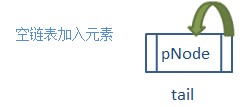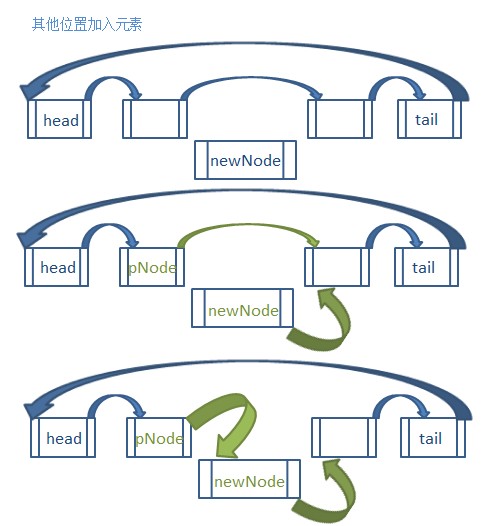单向循环链表的C++实现
单向循环链表与单向链表相比,其尾结点的下一个结点指向首元素,这样就构成了一个环:
单向循环链表的结点定义,与单向链表的结点定义一致:
#ifndef SIMPLENODE_HPP
#define SIMPLENODE_HPP
template<typename T> //定义一个模板T 写单链表
class SingleNode
{
public:
T element;
SingleNode* next;
SingleNode(const T& theElement,SingleNode* nextone=NULL)
:element(theElement),next(nextone) {}
};
#endif
当把各结点串起来组合成一个单向循环链表后,就需要添加对应的实现:
1.定义这个单向链表类的构造函数及析构函数
2.清空链表内所有元素
3.给出元素位置再返回对应结点
4.返回链表内部元素个数
5.判断这个链表是否为空
6.返回链表首尾的元素值
7.查找元素是否在此链表内,如果在则返回所在位置
8.从首端到尾端输出链表上的各元素
9.对链表插入元素以及删除元素
对应的类框架如下:
#ifndef CIRCLESINGLELINKLIST_HPP
#define CIRCLESINGLELINKLIST_HPP
#include<iostream>
#include"simplenode.hpp"
//这里默认位置pos的开始是从1开始,而不是从0开始
template<class T>
class CircleSingleLinkList //单链表类的定义
{
private:
SingleNode<T>* head; //链表头指针
SingleNode<T>* tail; //链表尾指针
int size; //元素个数
SingleNode<T>* GetPointAt(int pos)
{...}
public:
CircleSingleLinkList():head(),tail(),size(0) {}
~CircleSingleLinkList() {Clear();}
void Clear()
{...}
int Size() {...} //返回元素个数
bool isempty() {...} //返回链表是否为空
//-----------------------------------------------------
//这里添加元素
//------在尾部添加元素
void AddBack(T val)
{
SingleNode<T>* pNode=new SingleNode<T>(val);
if (isempty()) //链表为空时
{...}
else
{...}
size++;
}
//------在指定位置插入元素
bool AddAt(T val,int pos)
{
SingleNode<T>* pNode=NULL;
if (pos<=0 || pos>size)
{...}
if (pos==size) //在尾部插入元素
AddBack(val);
else if (pos==1) //在头部插入元素
{...}
else
{...}
size++;
return true;
}
//-----------------------------------------------
//这里删除元素
bool RemoveBack() //删除尾部元素
{
return RemoveAt(size);
}
bool RemoveAt(int pos) //删除指定位置元素
{
SingleNode<T>* pNode=NULL;
if (isempty())
{...}
if (pos<=0 || pos>size)
{...}
if (size==1) //只有1个元素时相当于清空链表
{
Clear();
}
if (pos==1) //并且size!=1, 删除头部元素时
{...}
else if (pos==size)
{...}
else
{...}
size--;
return true;
}
//---------------------------------------
T GetHeadVal()
{...}
T GetTailVal()
{...}
int Find(T val) //查找元素
{...}
void ShowAllVal() //从头到尾输出链表上的元素
{...}
};
#endif
给出类框架后,就该一个个给出对应的实现了。除了部分细节需要修改,其他的与单向链表的实现毫无二致:
1.构造函数与析构函数:
CircleSingleLinkList():head(),tail(),size(0) {}
~CircleSingleLinkList() {Clear();}2.清空链表内所有元素:
void Clear()
{
//从链表头到链表尾的方式逐个删除
const int nums=Size();
if (!isempty())
{
for (int k=1;k<=nums;++k)
{
SingleNode<T>* temp=head->next;
delete head;
head=temp;
size--;
}
}
//如果链表本来就为空,就没必要再进for循环了
}
3.给出元素位置再返回对应结点:
SingleNode<T>* GetPointAt(int pos)
{
SingleNode<T>* pNode=NULL;
if (pos<=0 || pos>size)
std::cout<<"out of range."<<std::endl; //链表当前位置越界,异常
else
{
pNode=head; //当前位置满足条件,则一开始在链表头
for (int i=1;i<=pos-1;++i)
pNode=pNode->next;
}
return pNode;
}要注意的是,遍历元素位置时避免pNode所获得的值越界,队首元素进不了for循环,改变不了pNode;队尾元素如果设置成i=1;i<=pos;++i,pNode会读取队尾的下一个值,那个值越界。最后就会返回一个未定义的元素。
4.返回首尾端元素、查找元素、输出所有元素、返回元素个数、判断列表是否为空:
T GetHeadVal()
{
if (isempty())
{
std::cout<<"the link list is empty"<<std::endl;
return NULL; //return NULL
}
return head->element;
}
T GetTailVal()
{
if (isempty())
{
std::cout<<"the link list is empty"<<std::endl;
return NULL; //return NULL
}
return tail->element;
} int Find(T val) //查找元素
{
int pos=1; //从起始位置1号位开始
SingleNode<T>* findNode=head;
do
{
if (findNode->element==val)
return pos;
findNode=findNode->next;
pos++;
}
while (findNode!=head);
std::cout<<"we can't find it,return -1"<<std::endl;
return -1;
} void ShowAllVal() //从头到尾输出链表上的元素
{
SingleNode<T>* findNode=head;
do
{
std::cout<<findNode->element<<" ";
findNode=findNode->next;
}
while (findNode!=head);
std::cout<<"最后一个元素的下一个元素是"<<findNode->element<<std::endl;
std::cout<<std::endl;
} int Size() {return size;} //返回元素个数
bool isempty() {return size==0?true:false; } //返回链表是否为空 由于此时,链表已成环状,所以要用一个循环进行控制,如果满足条件或者已经遍历一圈,要注意跳出,以免陷入死循环。
5.链表中加入元素:
这里也分四种情况讨论:
①插入元素位置越界
②在尾部插入元素
③在头部插入元素
④在其他位置插入元素
若插入元素成功,记得元素个数+1。这里用图示例空链表插入元素以及非空链表其他位置插入元素,其他情况读者们可以自己试着画图:
代码如下:
//这里添加元素
//------在尾部添加元素
void AddBack(T val)
{
SingleNode<T>* pNode=new SingleNode<T>(val);
if (isempty()) //链表为空时
{
head=pNode; tail=pNode;
tail->next=head;
}
else
{
tail->next=pNode;
tail=pNode;
tail->next=head;
}
size++;
}
//------在指定位置插入元素
bool AddAt(T val,int pos)
{
SingleNode<T>* pNode=NULL;
if (pos<=0 || pos>size)
{
std::cout<<"out of range."<<std::endl;
return false;
}
if (pos==size) //在尾部插入元素
AddBack(val);
else if (pos==1) //在头部插入元素
{
pNode=new SingleNode<T>(val);
pNode->next=head;
head=pNode;
tail->next=head;
}
else
{
//返回插入位置前面一个的位置指针
SingleNode<T>* pNode=GetPointAt(pos-1);
SingleNode<T>* newNode=new SingleNode<T>(val);
newNode->next=pNode->next;
pNode->next=newNode;
}
size++;
return true;
}
6.链表中删除元素:
这里也分五种情况讨论:
①链表为空
②删除元素位置越界
③在尾部删除元素
④在头部删除元素
⑤在其他位置删除元素
若删除元素成功,记得元素个数-1。这里没给出图示例,读者们可以自己试着画图
代码如下:
//这里删除元素
bool RemoveBack() //删除尾部元素
{
return RemoveAt(size);
}
bool RemoveAt(int pos) //删除指定位置元素
{
SingleNode<T>* pNode=NULL;
if (isempty())
{
std::cout<<"the link list is empty"<<std::endl;
return false;
}
if (pos<=0 || pos>size)
{
std::cout<<"out of range."<<std::endl;
return false;
}
if (size==1) //只有1个元素时相当于清空链表
{
Clear();
}
if (pos==1) //并且size!=1, 删除头部元素时
{
pNode=head;
head=head->next;
tail->next=head;
delete pNode;
}
else if (pos==size)
{
SingleNode<T>* pPreNode=GetPointAt(pos-1);
pNode=pPreNode->next;
pPreNode->next=pNode->next;
delete pNode;
tail=pPreNode;
tail->next=head;
}
else
{
SingleNode<T>* pPreNode=GetPointAt(pos-1);
pNode=pPreNode->next;
pPreNode->next=pNode->next;
delete pNode;
}
size--;
return true;
}
最后,将上述实现放入之前所说的类框架后,就完成任务了。
参考文献:
4.http://blog.csdn.net/mourinho_my_idol/article/details/12570609
























 8218
8218











 被折叠的 条评论
为什么被折叠?
被折叠的 条评论
为什么被折叠?








